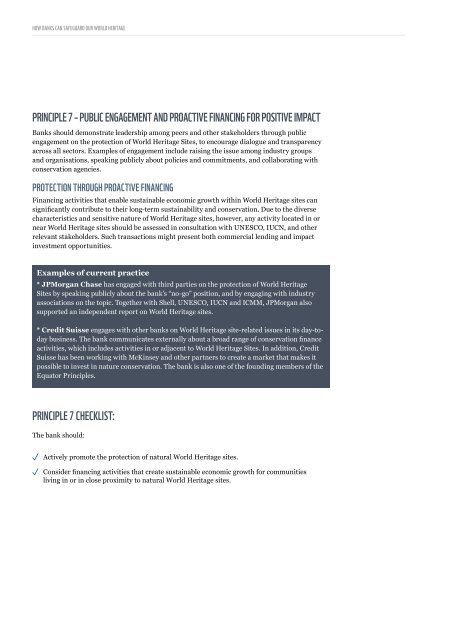Bios-Cons-Nat-Pro-155
Create successful ePaper yourself
Turn your PDF publications into a flip-book with our unique Google optimized e-Paper software.
HOW BANKS CAN SAFEGUARD OUR WORLD HERITAGE<br />
31<br />
PRINCIPLE 7 – PUBLIC ENGAGEMENT AND PROACTIVE FINANCING FOR POSITIVE IMPACT<br />
Banks should demonstrate leadership among peers and other stakeholders through public<br />
engagement on the protection of World Heritage Sites, to encourage dialogue and transparency<br />
across all sectors. Examples of engagement include raising the issue among industry groups<br />
and organisations, speaking publicly about policies and commitments, and collaborating with<br />
conservation agencies.<br />
PROTECTION THROUGH PROACTIVE FINANCING<br />
Financing activities that enable sustainable economic growth within World Heritage sites can<br />
significantly contribute to their long-term sustainability and conservation. Due to the diverse<br />
characteristics and sensitive nature of World Heritage sites, however, any activity located in or<br />
near World Heritage sites should be assessed in consultation with UNESCO, IUCN, and other<br />
relevant stakeholders. Such transactions might present both commercial lending and impact<br />
investment opportunities.<br />
Examples of current practice<br />
* JPMorgan Chase has engaged with third parties on the protection of World Heritage<br />
Sites by speaking publicly about the bank’s “no-go” position, and by engaging with industry<br />
associations on the topic. Together with Shell, UNESCO, IUCN and ICMM, JPMorgan also<br />
supported an independent report on World Heritage sites.<br />
* Credit Suisse engages with other banks on World Heritage site-related issues in its day-today<br />
business. The bank communicates externally about a broad range of conservation finance<br />
activities, which includes activities in or adjacent to World Heritage Sites. In addition, Credit<br />
Suisse has been working with McKinsey and other partners to create a market that makes it<br />
possible to invest in nature conservation. The bank is also one of the founding members of the<br />
Equator Principles.<br />
RECOMMENDATIONS AT A GLANCE<br />
This report recommends that banks work to safeguard World Heritage by:<br />
• Understanding the risks of financing extractive activities in World Heritage<br />
sites and the role banks can play in protecting their Outstanding Universal<br />
Value (p 10-12)<br />
• Engaging internally to ensure buy in from all parts of the business, including<br />
Board, CEO and operational staff (p 18)<br />
• Implementing a bank wide no-go World Heritage site policy for new and<br />
existing industrial scale activities, such as extractives, in order to protect the<br />
Outstanding Universal Value of World Heritage sites and their buffer zones.<br />
(p 14-17)<br />
• Expanding scope of policy application beyond project finance to all parts of a<br />
bank’s operations to include corporate lending (p 15-16)<br />
• Reviewing existing environmental and social risk management procedures<br />
and ensure World Heritage site data/ information is included to identify<br />
threats as early as possible (p 21-25)<br />
• Integrating World Heritage site questions into the onboarding and Know your<br />
client (KYC) process (p 23-25)<br />
• Collaborating with other banks and/or industry groups on protection of<br />
World Heritage sites (p 30)<br />
• Making commitments public and lodging bank policy with the UNESCO<br />
World Heritage Centre so that it can be formally recognised (p 29)<br />
• Engaging with the extractives sector (including clients and potential clients)<br />
to achieve improved disclosure on this issue and the adoption of industrywide<br />
no-go and no-impact commitments. (p 26)<br />
PRINCIPLE 7 CHECKLIST:<br />
The bank should:<br />
✓✓<br />
✓✓<br />
Actively promote the protection of natural World Heritage sites.<br />
<strong>Cons</strong>ider financing activities that create sustainable economic growth for communities<br />
living in or in close proximity to natural World Heritage sites.


